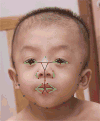Noonan syndrome in diverse populations
- PMID: 28748642
- PMCID: PMC5710841
- DOI: 10.1002/ajmg.a.38362
Noonan syndrome in diverse populations
Abstract
Noonan syndrome (NS) is a common genetic syndrome associated with gain of function variants in genes in the Ras/MAPK pathway. The phenotype of NS has been well characterized in populations of European descent with less attention given to other groups. In this study, individuals from diverse populations with NS were evaluated clinically and by facial analysis technology. Clinical data and images from 125 individuals with NS were obtained from 20 countries with an average age of 8 years and female composition of 46%. Individuals were grouped into categories of African descent (African), Asian, Latin American, and additional/other. Across these different population groups, NS was phenotypically similar with only 2 of 21 clinical elements showing a statistically significant difference. The most common clinical characteristics found in all population groups included widely spaced eyes and low-set ears in 80% or greater of participants, short stature in more than 70%, and pulmonary stenosis in roughly half of study individuals. Using facial analysis technology, we compared 161 Caucasian, African, Asian, and Latin American individuals with NS with 161 gender and age matched controls and found that sensitivity was equal to or greater than 94% for all groups, and specificity was equal to or greater than 90%. In summary, we present consistent clinical findings from global populations with NS and additionally demonstrate how facial analysis technology can support clinicians in making accurate NS diagnoses. This work will assist in earlier detection and in increasing recognition of NS throughout the world.
Keywords: Africa; Asia; Latin America; Middle East; Noonan syndrome; diverse populations; facial analysis technology.
© 2017 Wiley Periodicals, Inc.
Figures








References
-
- Addissie YA, Kotecha U, Hart RA, Martinez AF, Kruszka P, Muenke M. Craniosynostosis and Noonan syndrome with KRAS mutations: Expanding the phenotype with a case report and review of the literature. Am J Med Genet A. 2015;167A(11):2657–2663. - PubMed
-
- Allanson JE, Hall JG, Hughes HE, Preus M, Witt RD. Noonan syndrome: the changing phenotype. Am J Med Genet. 1985;21(3):507–514. - PubMed
-
- Allanson JE, Roberts AE. Noonan Syndrome. In: Pagon RA, Adam MP, Ardinger HH, Wallace SE, Amemiya A, Bean LJH, Bird TD, Ledbetter N, Mefford HC, Smith RJH, Stephens K, editors. GeneReviews(R) Seattle (WA): 1993.
-
- Aoki Y, Niihori T, Banjo T, Okamoto N, Mizuno S, Kurosawa K, Ogata T, Takada F, Yano M, Ando T, Hoshika T, Barnett C, Ohashi H, Kawame H, Hasegawa T, Okutani T, Nagashima T, Hasegawa S, Funayama R, Nagashima T, Nakayama K, Inoue S, Watanabe Y, Ogura T, Matsubara Y. Gain-of-function mutations in RIT1 cause Noonan syndrome, a RAS/MAPK pathway syndrome. Am J Hum Genet. 2013;93(1):173–180. - PMC - PubMed
MeSH terms
Substances
Grants and funding
LinkOut - more resources
Full Text Sources
Other Literature Sources
Medical
Miscellaneous

